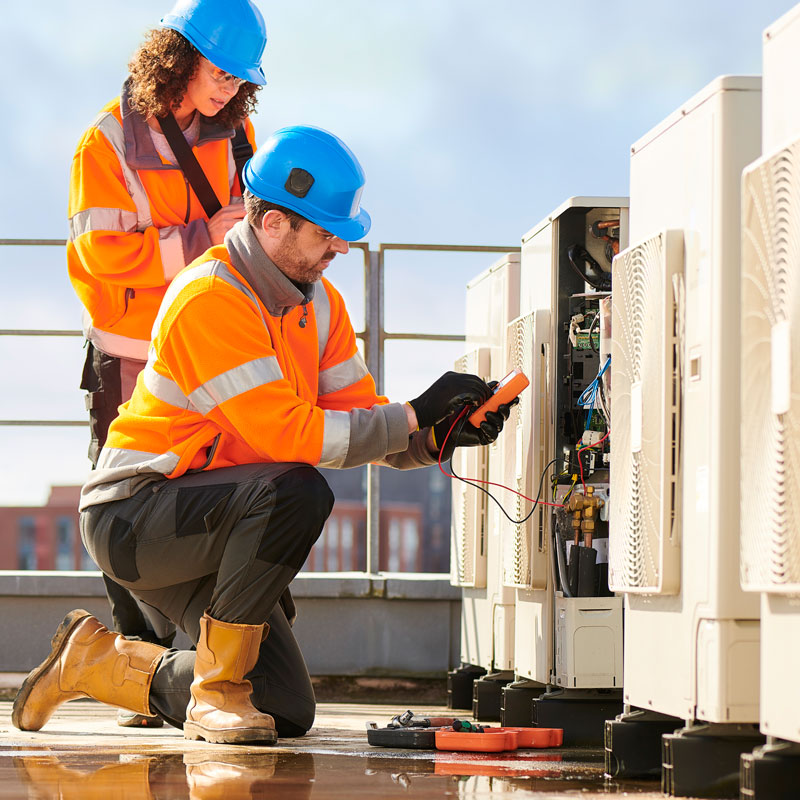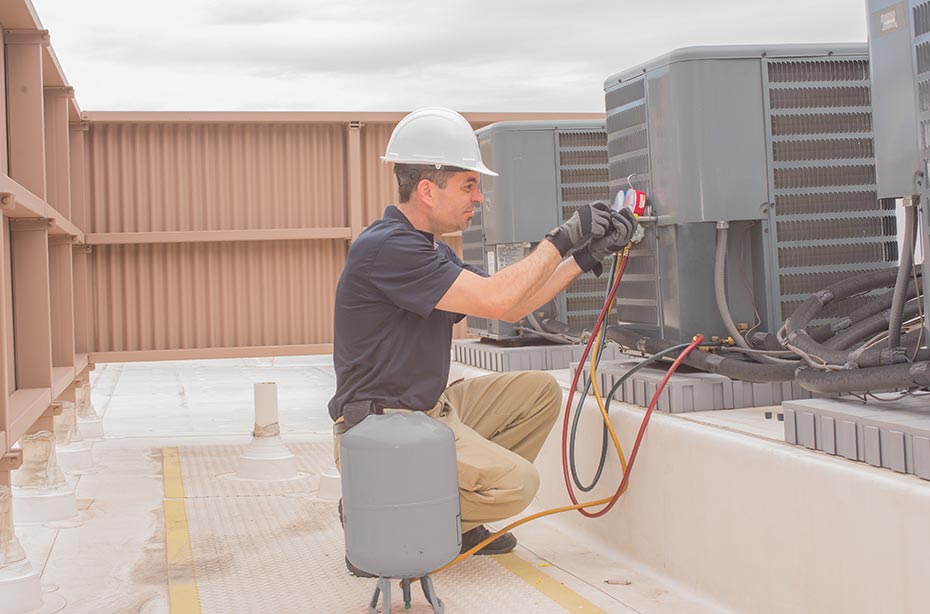Why ductless mini splits Outperform Traditional HVAC Setups
Why ductless mini splits Outperform Traditional HVAC Setups
Blog Article
How a Heatpump and Furnace Collaborate to Maximize Your Home's Home heating Effectiveness
Understanding exactly how a warmth pump and heater work with each other is crucial for home owners seeking effective home heating options. Each system has its strengths, supplying a balanced method to home convenience. The heatpump masters moderate temperature levels, while the heater delivers rapid warmth during extreme cold. This synergy not just lowers power expenses however also enhances the life expectancy of both appliances. What variables affect this collaboration, and exactly how can homeowners maximize their benefits?
Recognizing Warm Pumps: Just How They Work
Lots of people might be unfamiliar with their inner workings, heat pumps play an important function in modern-day heating systems. These gadgets operate by transferring warmth from one place to an additional, using the concepts of thermodynamics. In colder months, a warm pump extracts warm from the outdoors air, ground, or water, and transfers it inside your home to warm the space. On the other hand, during warmer months, it can turn around the process, working as an a/c by getting rid of warmth from inside to the outside.Heat pumps are composed of an evaporator, condenser, compressor, and expansion shutoff. The cooling agent within the system soaks up warm as it evaporates at low temperature levels and pressures. The compressor then raises the stress and temperature level of the cooling agent, permitting it to release warmth as it condenses. This reliable procedure can considerably lower energy usage contrasted to conventional home heating techniques, making heatpump a lasting selection for environment control in homes.
The Role of Heaters in Home Home Heating
Heating systems play a crucial duty in home heating by offering a trusted source of heat throughout the chillier months. They operate by creating warm through combustion or electric resistance, distributing it throughout the home by means of air ducts or glowing systems. The performance of a heating system is commonly measured by its Annual Gas Usage Effectiveness (AFUE) ranking, which shows just how properly the system transforms fuel into heat.Furnaces can utilize various power sources, including natural gas, oil, electrical energy, or gas, allowing home owners to select one of the most ideal choice for their needs. Unlike heatpump, which might have a hard time in extreme cool, furnaces preserve constant efficiency, making sure that interior temperatures remain comfortable regardless of outside problems. Additionally, contemporary heaters typically come equipped with innovative technology, such as smart thermostats and variable-speed blowers, boosting their effectiveness and responsiveness. This convenience makes heaters a critical element in all-encompassing home heating methods.

Benefits of Utilizing Both Solutions With Each Other
Combining the strengths of both heaters and warmth pumps can cause a much more efficient and reliable home heating option. Making use of both systems allows property owners to make use of the warmth pump's energy efficiency during milder temperature levels while depending on the furnace for even more severe cold problems. This double method can considerably reduce energy costs, as heatpump take in much less electrical power than traditional home heating approaches when temperatures are moderate.Additionally, utilizing both systems together can boost convenience degrees in the home. Heatpump can offer constant, also home heating, while heating systems can quickly increase ambient temperatures when needed. Additionally, the integration of both systems can prolong the life expectancy of devices by decreasing wear and tear on each system, as they share the workload. Inevitably, house owners can enjoy a well balanced, economical home heating remedy that changes flawlessly to differing weather condition conditions, ensuring a warm and welcoming home throughout the cold weather.
Just How Heat Pumps and Furnaces Enhance Each Various Other
When home owners incorporate warmth pumps and heating systems, they create a corresponding heater that takes full advantage of efficiency and convenience. Warmth pumps run by transferring warmth from the outside air or ground, making them very reliable in moderate environments. They excel throughout milder temperatures, supplying cost-efficient home heating. Conversely, furnaces produce warmth via combustion or electrical resistance, supplying solid, immediate heat during severe cold conditions.The mix of these two systems permits for vibrant changes based upon temperature fluctuations. During warmer months or milder winter days, the warmth pump can take the lead, saving energy and lowering expenses. As temperatures decrease, the heating system can flawlessly engage, making certain regular heat throughout the home. This synergy not only enhances power use but likewise enhances the life-span of both systems, as each system runs within its optimal efficiency array. With each other, they develop a balanced environment that adjusts to varying climate demands.
Enhancing Effectiveness: Tips for Homeowners
Home owners can boost their home heating effectiveness through a number of sensible techniques. Developing a regular upkeep timetable, incorporating smart thermostat technology, and carrying out reliable insulation and securing services are vital actions. These steps not only improve comfort but likewise decrease energy prices.
Regular Upkeep Set Up
To ensure maximum home heating effectiveness, developing a normal upkeep schedule is necessary for any kind of home. Homeowners must prioritize regular examinations of both heat pumps and furnaces to identify peak performance. This consists of changing air filters each to 3 months, as stopped up filters can considerably lower efficiency. useful content Additionally, scheduling professional upkeep at the very least annually enables service technicians to determine and attend to prospective issues prior to they intensify. Property owners ought to likewise cleanse the heat pump's exterior unit to avoid particles buildup that can prevent air movement. By sticking to a normal upkeep routine, property owners not only boost their heater' efficiency however also extend their life-span, resulting in better convenience and decreased energy costs throughout the chillier months.
Smart Thermostat Integration
Incorporating a wise thermostat into a home heater can significantly improve energy effectiveness, specifically as it enables for exact control over temperature setups. These tools can learn the house owner's schedule and preferences, instantly adjusting the temperature to maximize comfort while lessening energy use. They can reduce heating during times when the home is vacant, decreasing unneeded usage. Numerous smart thermostats additionally offer real-time energy usage information, enabling homeowners to make informed decisions about visit their heating practices. In addition, remote accessibility through mobile phone applications allows users to adjust setups from anywhere, ensuring the home is warm upon return. Overall, wise thermostat assimilation not just improves comfort yet significantly adds to energy financial savings and effectiveness.
Insulation and Sealing Solutions
Smart thermostats play a crucial role in power performance, but their efficiency can be considerably boosted by proper insulation and sealing solutions. House owners must focus on shielding floors, wall surfaces, and attics to reduce warmth loss. Top notch insulation products, such as spray foam or fiberglass, can significantly boost thermal resistance. Additionally, securing gaps around ducts, home windows, and doors prevents chilly air infiltration and warm escape. Weatherstripping and caulking work techniques for addressing these leaks - ductless mini splits. Routine evaluations for air leakages, together with making use of blower door examinations, can help determine problem areas. By spending in insulation and sealing, homeowners can optimize the efficiency of their heating unit, ultimately bring about reduced power intake and reduced energy bills
Typical Misconceptions Concerning Warm Pumps and Furnaces
What false impressions border warmth pumps and furnaces? Many individuals erroneously think that heatpump are ineffective in cooler climates. Actually, modern-day heatpump are created to run successfully also in reduced temperatures, supplying reliable home heating throughout winter. An additional common myth is that heaters are always extra efficient than heatpump. This depends on the details energy sources and performance scores of the devices in question. Some might additionally assume that making use of both systems concurrently is unnecessary, however actually, this mix can optimize home heating effectiveness, especially throughout severe sites weather conditions. Additionally, people usually assume that heatpump call for continuous upkeep, when actually, they have similar maintenance requires to typical home heating systems. By disproving these misconceptions, home owners can make even more informed choices concerning their heating choices, inevitably causing boosted comfort and power performance in their homes.
Upkeep Factors To Consider for Combined Equipments

Regularly Asked Inquiries
Can Heat Pumps Work Efficiently in Exceptionally Cold Climates?
Heatpump can have a hard time in exceptionally cold environments as a result of decreased efficiency and heat removal restrictions. Developments in innovation have actually led to models made for much better performance in such problems, boosting their feasibility in severe atmospheres.
How Much Time Do Warmth Pumps and Furnaces Usually Last?
Warmth pumps normally last 15 to two decades, while heaters have a lifespan of 15 to thirty years. Normal maintenance can expand their durability, making sure effective operation and decreasing the requirement for early substitutes.

What Is the Ordinary Cost of Putting Up Both Systems?
The average cost of installing both a heatpump and a heating system normally ranges in between $5,000 to $10,000 - heat pump installation ooltewah tn. Aspects influencing this expense include system dimension, installation intricacy, and local labor prices
Are There Tax Rewards for Making Use Of Energy-Efficient Heating Equipments?
Lots of homeowners ask about tax incentives for energy-efficient furnace. Numerous government and state programs often supply discounts or credit histories, motivating the fostering of sustainable innovations to minimize power consumption and promote environmental responsibility.
How Do I Choose the Right Size Heatpump and Furnace?
Selecting the right size warmth pump and heater includes determining the home's square video, thinking about insulation high quality, and assessing neighborhood climate. Consulting a specialist can assure suitable system efficiency and power effectiveness based upon particular requirements. furnace replacement. Understanding exactly how a warm pump and furnace job with each other is vital for homeowners looking for reliable home heating solutions. In cooler months, a heat pump extracts warmth from the outdoors air, ground, or water, and transfers it indoors to heat the living area. When house owners incorporate warmth pumps and heating systems, they develop a corresponding home heating system that optimizes performance and comfort. Heat pumps operate by moving heat from the outside air or ground, making them highly efficient in modest environments. Warmth pumps can have a hard time in extremely cool climates due to decreased efficiency and warm extraction limitations
Report this page